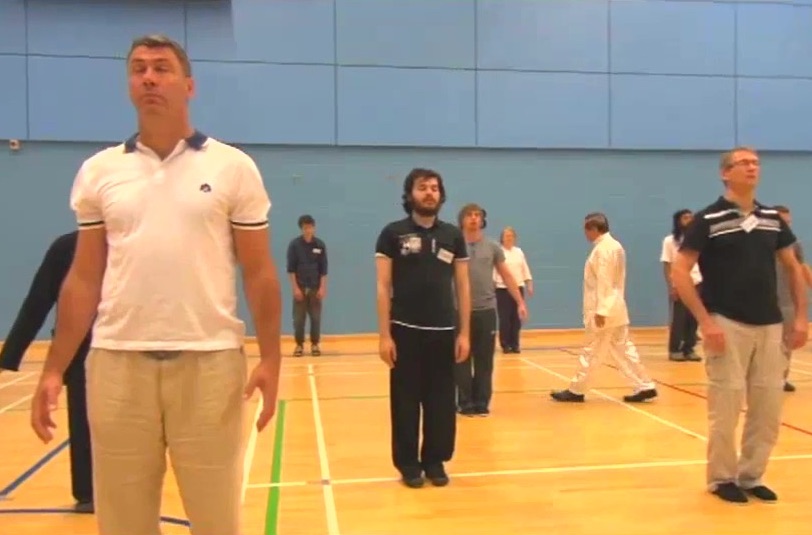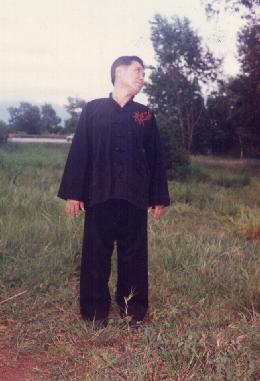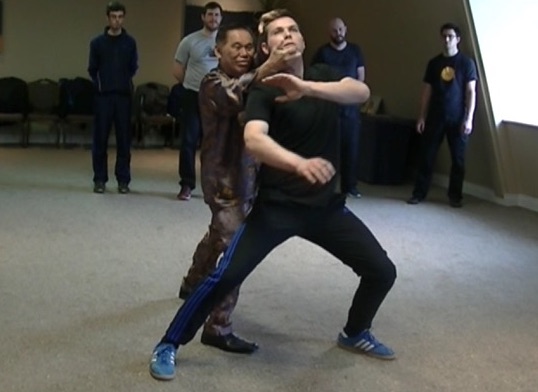SELECTION OF QUESTIONS AND ANSWERS
JULY 2022 PART 3
Note
: The Q & A Series will end on Apr 25 Part 1, but he Series will carry on as usual.

"Cosmic Shower"
Question 1
It is an honour to write to you and to know you and your family are in great health!
In Holland, we are close to getting a vaccination; by September the entire adult population will have had one. Are you going to teach again after the pandemic is under control? I would love to visit you again and attend a course!
Which training methods in Shaolin Wahnam are the most effective, if all things are equal, if you wish to train your mind to remain unmoved by external events?
— Sifu Roeland Dijkema, Shaolin Wahnam Netherlands
Answer
My wife, my children, my grandchildren and I are very well.Actually you don't need a vaccination, but it may be useful when you want to travel. I shall teach again when the world reopens, but my world travels will be reduced. I shall probably teach in Malaysia, though I may travel out once awhile.
"Small Universe" and "Cosmic Shower" are probably the most effective to keep "shen" (or "mind") unmoved by external events. They will also increase the power of "shen".
Question 2
I've been approached by one of my former student enquiring whether I could provide the one-year money back guarantee chi kung healing for her close relative. The patient is a young lady at the age of 36, diagnosed with colon cancer stage 4 spread to the liver.
— Dr Foong, Holistic Health Cultivation Center, Kuala Lumpur, Malaysia.
Answer
Curing cancer is your strong point. Moreover it is non-contagious, but you need not be too close to the patent. Usually cancer patients let out some foul smell. The patient is very young, but her cancer has spread to her liver.
You should take up the chase. But she must pay first. Treatment will only commence when she has paid up.
Your patient will recover. This will help you to make your centre overcome so-called incurable diseases, making it the centre for the whole world.

"Turning Head"
Question 3
Since qualifying as a homeopathy doctor in 2013, I felt it's about time to build my personal practice.
I am still in contact with the marketer to set a couple of campaigns for homeopathy and the ebook launched.
Turning Head is useful for goitre, thyroid, iodum imbalance and Hashimoto's Disease. Is it correct that the above four conditions greatly benefited from this particular Lohan exercise?
— James, England
Answer
Homeopathy can overcome many diseases, but chi kung therapy can overcome so-called incurable diseases, but you must be very good. Hence we must charge high fees. The choice is yours.
Don't pay beforehand no matter how good a marketer claims himself or herself to be. You may pay a high commission.
"Turning Head", if you know how, can overcome goitre, thyroid, iodum imbalance and Hshimoto's Disease (i.e. an autoimmune disease causing inflammation and failure of the thyroid gland) but you must be very good.
Most people, however, practice "Turning Head" as gentle, physical exercise, and they are unaware of it, because the external form is similar. This is an important reason why chi kung (or "qigong" in Romanized Chinese) has to be learned from a master or at least a competent instructor.
Question 4
I wanted to send my profound thanks to Sifu for Sifu's kindness, support and advice to me during the past difficult years. During this time I was able to attend the Essence of Shaolin, the "Small Universe" and "Pakua" courses.
— John, Ireland
Answer
I am happy that your Ph.D is now complete.
The teaching of the Shaolin arts not only gives us good health, vitality, longevity, peak performance and spiritual joys irrespective of religion, but also enriches our daily life and the lives of others.
I am indeed proud of you, and look forward to your teaching of Wudang Kungfu and chi kung, and to spread kindness.

Combat application of Pakua Set
Question 5
Something confuses me and it is related to Buddhism. One of the precepts is not to kill any living thing or harm it? The reason why I want to know is because next week I am going to a Buddhist temple and hopefully to be converted to Buddhism.
— Brandon, USA
Answer
One of the chief rules of Buddhism is not to harm anybody. Hence, in Shaolin Kungfu one important art is "72 chin-na" (or "qin-na" in Romanized Chinese). It is actually compassionate. It grips an opponent so that the opponent can see a doctor trained in Chinese medicine or a kungfu master who knows "chin-na" to release the injury.
Another art called "dim mark" is also compassionate. It dots an opponent to numb the opponent's vital points or energy points, so that the opponent can see a Chinese trained doctor or a kungfu master who knows "dim mark" to release the injury. "Dim mark" is sometimes known as "a touch of death", but actually it is compassionate.
"Chin-na" and "dim mark" are known as the Shaolin Ultimates, the other Shaolin Ultimate being internal arts. In this particular case, internal arts are known as "noi kung", while "chin-na" and "dim-mark" are known as external arts, or "ngoi kung". Here internal arts cannot be seen, like Sinew Metamorphosis which involves energy and mind, whereas external arts can be seen, like the combat applications of "chin-na" and "dim mark".
In another respect, "chin-na" and "dim mark" are internal, as their training which involves energy and mind, cannot be seen. Kungfu terms are used for convenience, unlike scientific terms.
Most kungfu, as well as Karate, Taekwondo, Kickboxing, Western Boxing, Wrestling and MMA fighting are external as the combat applications of these arts can be seen. Most internal arts are internal, but some arts like hitting sandbags and lifting iron balls are external.
There is a saying in Chinese meaning "dim thou wei chee" (Cantonese Chinese) which literally means "touch attain yes arrive" which is quite non-sensical, but figuratively it means "just only touch an opponent". In kungfu combat a master just touches an opponent, as kungfu masters love life.
In combat, a kungfu master just touches an opponent, and the opponent will reply "seng yeong", which means "thank you for just touching my skin to be merciful" with the implication that the kungfu master could kill the opponent if he wanted to. Kungfu masters are courteous, unlike Karate, Taekwondo, Kickboxing, Western Boxing, Wrestling and MMA fighters who just exchange blows.
Why are kungfu masters generous when kungfu, any style of kungfu, is a martial art. It is because when kungfu is trained as a martial art, and not as a sport, qualities like perseverance, quick response, vibrant health, character development and spiritual joys are cultivated. But genuine kungfu is very rare. Kungfu is now trained as a sport with demonstrations and free exchange of blows like in Karate and Kickboxing.
However we train genuine kungfu in Shaolin Wahnam. If someone is foolhardy enough to challenge us like saying our art is useless for combat, we shall use kungfu on him, even killing him in a fight. We mean business, but we shall make sure everything is ready, like signing a life-death warranty and showing our combat in videos.
Question 6
So you personally recommend I abandon Karate and learn Kung Fu?
Answer
If you learn Karate, you learn a sport, not a martial art. There are safety rules where you exchange blows generously, and the blows are usually left unattained to. Now you don't even learn a sport, you learn how to bounce about using Kickboxing techniques and throw your Karate techniques to the winds.
In the past I used to recommend that a practitioner practiced kungfu; now I recommend that the practitioner learns from an instructor from Shaolin Wahnam to save time. You can have a list of Shaolin Wahnam instructors here.
I really don't mean to be presumptuous but in Shaolin Wahnam you will learn genuine high-level kungfu. There may be genuine kungfu taught in other schools, but I don't know them. In Shaolin Wahnam, while we use kungfu skills and techniques in our practice, we place more importance on good health, vitality, longevity, peak performance and spiritual joys irrespective of religion.
Most kungfu schools only perform demonstrations -- what genuine kungfu masters refer to as "flowery fist and embroidery legs", and they cannot use their kungfu skills and techniques.
You should attend my Intensive Chi Kung Course. You should read The Unbelievable Intensive Chi Kung Course. If you are unsatisfied, you do not have to pay any instruction fee.
If you are happy with my Intensive Chi Kung Course, you can then attend my Intensive Shaolin Kungfu Course. You should read The Wonderful Intensive Shaolin Kungfu Course. The choice is yours.
(Editorial Note: This question was asked early, but as Grandmaster Wong has a long waiting list -- now more than a year -- he is releasing the answer now.)

Shaolin Kungfu
Question 7
We are very lucky to have our wonderful Shaolin arts, to guide us through those difficult times! Thank you!
In addition to my daily training I love researching different kung fu styles, reading about history and legends and admiring past masters for their work.
Many Fujian-derived style like Wuzuquan, Southern Mantis, White Crane, Incense Shop Boxing, etc. are based on more or less the same set, namely: San Zhan! The structure and different features like using the Four Six Stance extensively, drag steps, etc. are very similar throughout the different styles.
I wonder why these Fujian Styles are all so similar, whereas the basic set taught in the Southern Shaolin Temple in Fujian (Four Gates) is quite different. Why do you think a form of San Zhan wasn't taught as the basic set in the Southern Shaolin Temple?
— Florian, Switzerland
Answer
"San Zhan" was also taught in the Shaolin Monasteries in Henan Province and Fujian Province. One reason why I taught "Four Gates" instead of "San Zhan" was historical. "Four Gates" was brought out of the Shaolin Monastery at Quanzhou in Fujian Province by our first patriach, the Venerable Jiang Nan, about 200 years ago.
The main purpose of "Four Gates" is to train bridges (or the forearms) and stances. The main purpose of "San Zhan" is to train internal force and combat application, but not many people know about these. Before training internal force and combat application, practitioners must be good at bridges and stances.
Hence, in our Shaolin Kungfu, "Four Gates" is a basic set, while "San Zhan" is a selective. Nevertheless, I have introduced combat sequences in our kungfu training to speed up combat application.
Teaching the Shaolin arts, which include Taijiquan or Wudang Kungfu, is an essential factor of Shaolin Wahnam, although I can now retire and let worthy masters carry on with the effort of passing the Shaolin arts to posterity. It was what my sifu, Sifu Ho Fatt Nam, asked me to do irrespective of culture and religion.
The "Four-Six Stance" of "San Zhan", which we call "Riding Dragon Stance", is popular. It minimizes shifting the "Bow-Arrow Stance" to the "False-Leg Stance" by means of body movement, and may cause an opponent to be unbalanced. It is a wonder that "San Zhan" has remained unchanged throughout the centuries.
Question 8
May I ask you politely how you intend to continue after this situation? Hopefully, are you considering teaching courses again?
As I think our aim in Shaolin Wahnam is to preserve the essence of kung fu, have you ever considered teaching a special course on Northern Shaolin Kung Fu, and on classical sets taught in the first Shaolin Temple in Henan? Unfortunately, I feel that especially these styles are much influenced by modern Wushu, with exaggerated acrobatics and focus on form exclusively, I would love to see them performed in a traditional way with focus on force and combat application.
Answer
I mainly teach Intensive Chi Kung Course, Intensive Shaolin Kungfu Course, Intensive Taijiquan Course, and some other special kungfu courses in Malaysia. I believe that my sifu, Sifu Ho Fatt Nam, asking me to travel round the world about 9 months a year to teach regional courses, is quite sufficient. I may still travel, possibly less.
Your suggestion that I teach a special course on Northern Shaolin Kungfu and on classical sets in the first Shaolin Monastery in Henan is interesting. I shall probably teach "San Zhan" which has remained unchanged throughout the centuries, and "Shaolin Tantui", the forerunner of Northern Shaolin. Those who have taken courses before may take the courses again as there are new things I may teach in the courses.
LINKS
Selected Reading
- Cosmic Shower and Spiritual Cultivation
- Overcoming Cancer and Experiencing Happinness from Within
- History and Philosophy of Wudang Taijiquan Set
- Buddhism and Reality
- Scenic Architecture
